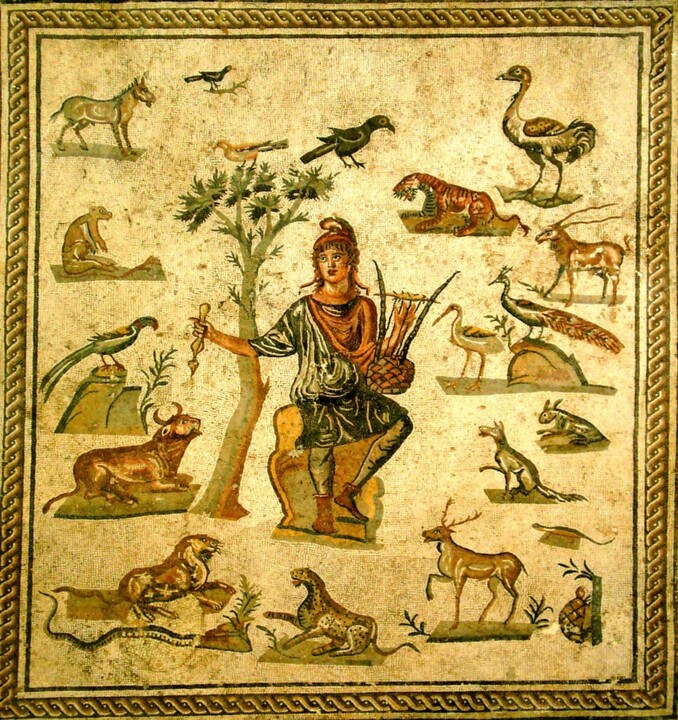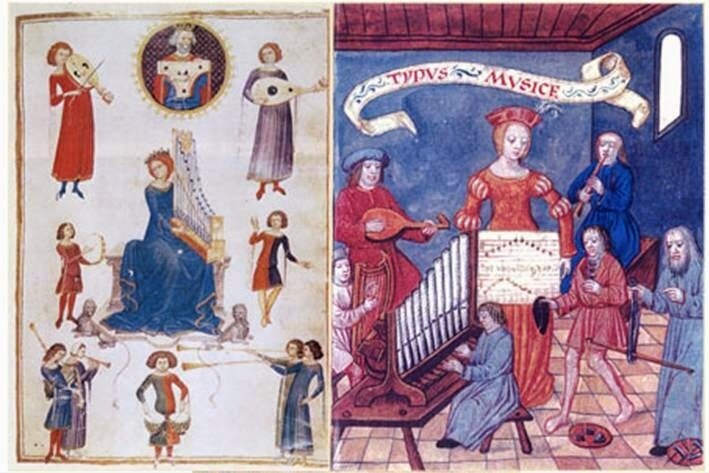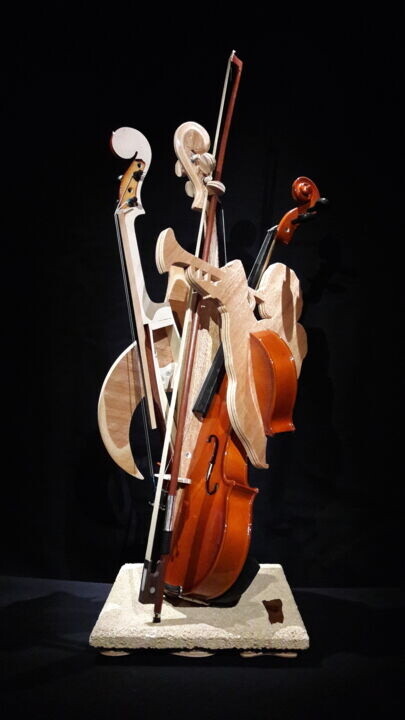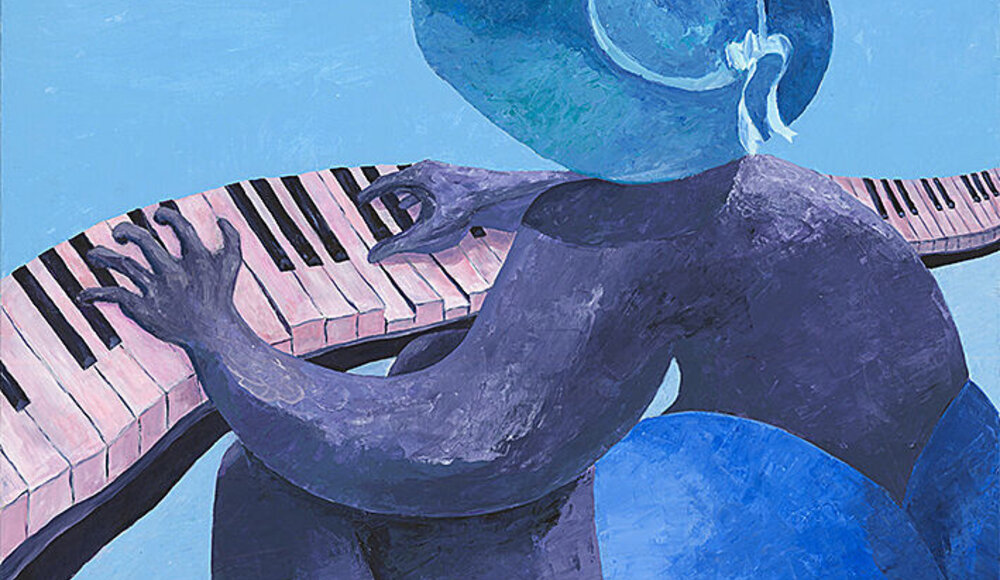 Cébé, Heavenly piano, 2014. Acrylic on canvas, 80 x 80 cm.
Cébé, Heavenly piano, 2014. Acrylic on canvas, 80 x 80 cm.
Music and art represent, without a shadow of a doubt, two related disciplines that, through the immateriality of sound and the enchantment of images, are able to reveal human feelings and experience, both in its positive and joyful sides and in its more introspective and serious ones. Precisely because of these peculiarities, the aforementioned arts have played a prominent role since antiquity, and in particular, since the dawn of classical civilizations, when, from their union, two distinct combinations were generated: art that tells music and art that supports music. Regarding the latter aspect, it is enough to refer to the Greek and Roman amphitheaters and theaters, such as, for example, the Theater of Epidaurus (Epidaurus, Greece), which, built in the 4th century B.C., represents a masterpiece of architecture designed with the purpose of maximizing acoustics.
 Polyclitus the Younger, Theater of Epidaurus, 340 B.C., Epidaurus.
Polyclitus the Younger, Theater of Epidaurus, 340 B.C., Epidaurus.
On the other hand, as far as art that tells the story of music is concerned, this pairing has been realized over the centuries through the work of major painters, graphic designers and sculptors, who, aimed at immortalizing, both musicians and musical instruments, have consequently also documented their evolution. In its earliest examples, this story is told to us by the statuettes and vases of early Mediterranean civilizations, just like the Lyre Player from the 2nd millennium B.C., from the Cycladic Islands. The latter marble figurine, depicting a man intent on playing the lyre, was made in the purest geometric schematization of the human form typical of Cycladic art. To represent the art-music relationship in the Hellenic world, on the other hand, we can take as an example the red-columned amphora with a black background, depicting Orpheus playing the lyre, a vascular work from Attica now housed in the Pergamon Museum in Berlin. The same "musical" myth is also reproposed in the Roman world and, more specifically, in the mosaic floor kept at the Archaeological Museum in Palermo, decorated with Orpheus surrounded by animals. Preceding the example of ancient Rome, however, are the Etruscan frescoes in the Necropolis of Tarquinia, capable of highlighting a more properly playful aspect of the world of music, since they immortalize lyre and aulos players accompanied by dancers.
 Lyre player, 2nd millennium BC, marble. Athens: National Museum.
Lyre player, 2nd millennium BC, marble. Athens: National Museum.  Orpheus surrounded by animals, 1st - 2nd cent. AD, Roman floor mosaic. Palermo: Archaeological Museum.
Orpheus surrounded by animals, 1st - 2nd cent. AD, Roman floor mosaic. Palermo: Archaeological Museum.
The history of the link between art and music continues into the Middle Ages, a time when, in addition to paintings and sculptures, illuminated manuscripts also became an important means of disseminating musical knowledge, just like the Remède de Fortune by the poet and musician Guillaume de Machaut, which, dating back to the 14th century, represents one of the most comprehensive artistic-literary sources on the subject. Still on the subject of this period, it is also important to mention the portals of Romanesque and Gothic cathedrals, which, in multiple instances, house sculptures of angels, or saints, armed with musical instruments. Examples of this association of art, religion and music are the Portal of St. Anne in Notre Dame in Paris and the Portal of Glory in Santiago de Compostela.
 Guillaume de Macaut, Remede de fortune, 4th cent., illuminated codex.
Guillaume de Macaut, Remede de fortune, 4th cent., illuminated codex.
A few centuries later, and more precisely in the late fifteenth century, some of the greatest Flemish masters narrated the world of music through art, just as can be seen in Hans Memling's Angels musician (c. 1485) and Hieronymus Bosch's The Garden of Earthly Delights (1480-1490). In the latter painting, however, the instruments, placed in the right panel of the triptych representing hell, seem to allude to the sound of a melody that is anything but pleasant, that is, a rather annoying and chaotic noise, also found in the combination of notes transcribed in the pentagram present within the work. Like Bosch, Caravaggio, in the painting Rest on the Flight into Egypt from 1595, was also shown to be very attentive to the messages cast by the scores. In fact, the sheet music of a precise tune, that of Flemish composer Noel Bauldewijn, based on the text of the Song of Songs and titled "Quam pulchra es," is given in Joseph's hands.
 H. Bosch, The Garden of Earthly Delights, 1480. Oil on panel. Madrid: Prado Museum.
H. Bosch, The Garden of Earthly Delights, 1480. Oil on panel. Madrid: Prado Museum.
 Caravaggio, Rest on the Flight into Egypt , 1595. Oil on canvas. Rome: Doria Pamphilj Gallery.
Caravaggio, Rest on the Flight into Egypt , 1595. Oil on canvas. Rome: Doria Pamphilj Gallery.
Skipping a time span of about two centuries, the nineteenth century is characterized by a plus intimate view of the relationship between art and music; in fact, the players portrayed in this era turn out to be more collected in their studies and, consequently, in their world. An example of this is Thomas Couture's The Bagpipe Player, who, totally absorbed in his practice, does not care about his surroundings. Finally, it is important to highlight how, with the arrival of the twentieth century, the art-music pair was indelibly modified by the Avant-gardes, inexorable bearers of unprecedented visions on reality. Emblematic demonstration of what has just been affirmed is Pablo Picasso's Guitar (1912-1913), which, currently preserved at the MOMA in New York, represents a three-dimensional idealization of music, aimed at acquiring "concreteness" through a tangible volume, thickness and form. In addition, the aforementioned masterpiece, being for all intents and purposes capable of reproducing sounds, is no longer just a work of art representing something, but also a medium expressing the existence of an instrument.
 Kristof Toth, Diptych sculpture cellist + harp player, 2020. Sculpture, bronze on stone, 52 x 30 x 15cm / 10.00 kg.
Kristof Toth, Diptych sculpture cellist + harp player, 2020. Sculpture, bronze on stone, 52 x 30 x 15cm / 10.00 kg.
 Karen Axikyan, Melody, 2020. Sculpture, Metals on metal, 41 x 26 x 10 cm / 1.20 kg.
Karen Axikyan, Melody, 2020. Sculpture, Metals on metal, 41 x 26 x 10 cm / 1.20 kg.
The combination of art and music in the works of Artmajeur's artists
The timeless birthmark to tell the story of the musical world through art continues even today; in fact, this desire animates the work of a great many contemporary artists, including, those of Artmajeur, who, oftentimes, have been inspired by the greatest figurative examples of the past. This will to emulate the highest tradition of art, however, is accompanied by a strong desire for innovation, which, aimed at enriching the historical link between art and music, is well manifested in the artworks of Pierre Duquoc, Massimo Iacovelli and Jamie Lee.
 Pierre Duquoc, Ghost #36, 2022. Photography, Manipulated photography / Digital photograph on paper, 50 x 75 cm.
Pierre Duquoc, Ghost #36, 2022. Photography, Manipulated photography / Digital photograph on paper, 50 x 75 cm.
Pierre Duquoc: Ghost #36
Pierre Duquoc's shot, titled Ghost #36, captures a female violin player using a somewhat paradoxical technique; in fact, as the artist himself claimed, it is not customary for a photographer to want to make his works blurry. In reality, however, Duquoc pushed the aforementioned contradiction even further, as he recreated the blur from originally sharp shots. This procedure pursues the intent to investigate the small disappearances of everyday life, that is, those ephemeral moments captured and stored in our memory, which, subsequently, are transformed into memories. Performances on stage, often marked by repetitive and orderly movements, turn out to be particularly suitable to render the concept of reminiscence also because, the musicians, once the performance is over, generate a kind of "disappearance" that fosters re-enactments. On the subject of art history, on the other hand, Ghost #36 has multiple affinities with Giacomo Balla's The Hands of the Violinist, a painting in which the Italian master captured, through an optical effect close to photographic blurring, the movement of a musician.
 Massimo Iacovelli, Formidable, 2022. Sculpture-wood, 74 x 24 x 24 cm.
Massimo Iacovelli, Formidable, 2022. Sculpture-wood, 74 x 24 x 24 cm.
Massimo Iacovelli: Formidable
Iacovelli's sculpture, made with a real violin, is the result of the decomposition of the latter musical instrument, aimed at generating multiple, fragmented and dissected visions of the object in the viewer. In this context, the artwork presents itself to the viewer in all its relativity, since, while displaying the known image of a violin, it re-proposes it in an unprecedented and unconventional way, released from any custom. Moreover, Formidable is reminiscent of Arman's iconic decomposed violin sculptures, conceived with the same purpose of showing, at the same time, different forms and perspectives in a single object. An exponent along with other artists such as Yves Klein and Jean Tinguely of Nouveau Réalisme, the aforementioned French master had the habit of recovering real and obsolete objects in order to break them down into their forms by altering their perception and revealing their essence. Consequently, the peculiarities of Iacovelli's work turn out to be highly akin to the highest art historical tradition.
 Jamie Lee, Buddy Rich, 2022. Acrylic / spray paint on canvas, 70 x 70 cm.
Jamie Lee, Buddy Rich, 2022. Acrylic / spray paint on canvas, 70 x 70 cm.
Jamie Lee: Buddy Rich
Jamie Lee's Pop painting depicts, in styles borrowed from Roy Lichtenstein, the famous American drummer and bandleader Buddy Rich. Such a choice of subject should not surprise us, as Pop art has always been closely linked to the musical world; in fact, since the twentieth century, the most popular forms of culture tended toward multimedia, that is, the combination of words, music, images and dance that created complex artistic results. Moreover, in its constant reference to modernity and new mass phenomena, the aforementioned movement obviously took music and its protagonists into account. Obvious references to the musical world can be found in the work of Peter Blake, David Hockney, Richard Hamilton and Andy Warhol, so that the work of the artist from Artmajeur falls squarely within a great tradition.


 Olimpia Gaia Martinelli
Olimpia Gaia Martinelli























